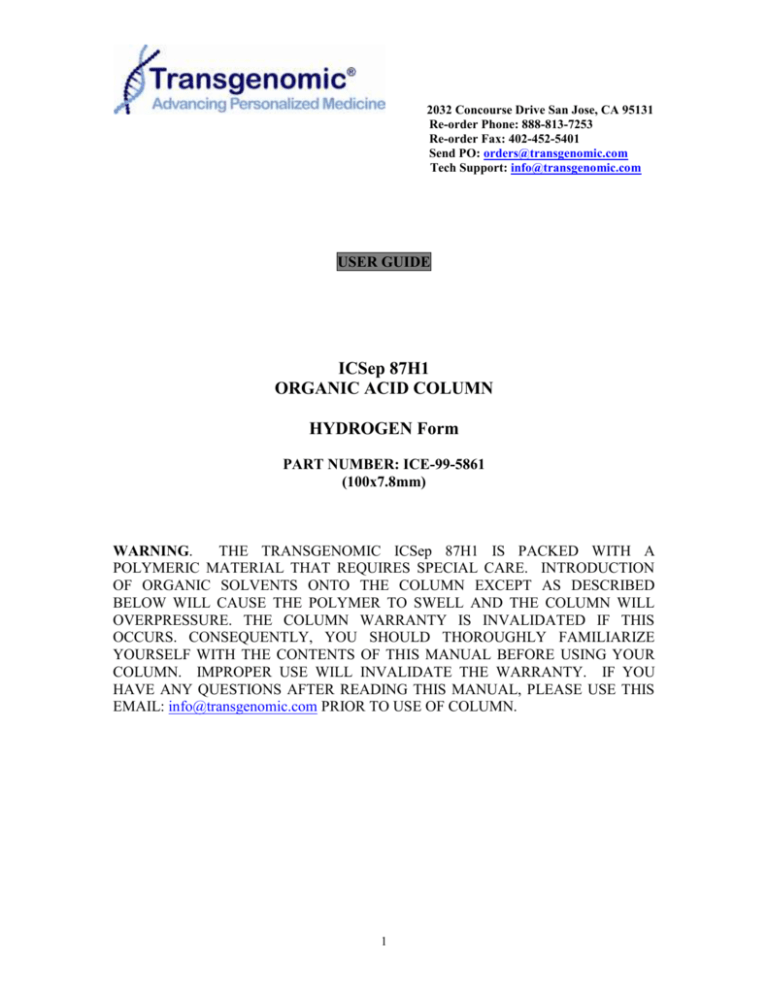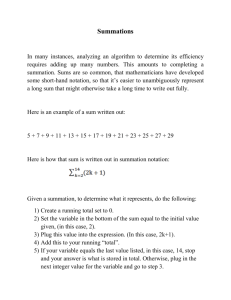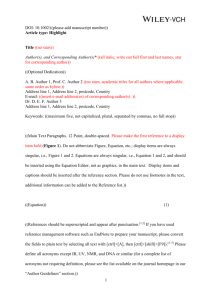
2032 Concourse Drive San Jose, CA 95131
Re-order Phone: 888-813-7253
Re-order Fax: 402-452-5401
Send PO: orders@transgenomic.com
Tech Support: info@transgenomic.com
USER GUIDE
ICSep 87H1
ORGANIC ACID COLUMN
HYDROGEN Form
PART NUMBER: ICE-99-5861
(100x7.8mm)
WARNING.
THE TRANSGENOMIC ICSep 87H1 IS PACKED WITH A
POLYMERIC MATERIAL THAT REQUIRES SPECIAL CARE. INTRODUCTION
OF ORGANIC SOLVENTS ONTO THE COLUMN EXCEPT AS DESCRIBED
BELOW WILL CAUSE THE POLYMER TO SWELL AND THE COLUMN WILL
OVERPRESSURE. THE COLUMN WARRANTY IS INVALIDATED IF THIS
OCCURS. CONSEQUENTLY, YOU SHOULD THOROUGHLY FAMILIARIZE
YOURSELF WITH THE CONTENTS OF THIS MANUAL BEFORE USING YOUR
COLUMN. IMPROPER USE WILL INVALIDATE THE WARRANTY. IF YOU
HAVE ANY QUESTIONS AFTER READING THIS MANUAL, PLEASE USE THIS
EMAIL: info@transgenomic.com PRIOR TO USE OF COLUMN.
1
2032 Concourse Drive San Jose, CA 95131
Re-order Phone: 888-813-7253
Re-order Fax: 402-452-5401
Send PO: orders@transgenomic.com
Tech Support: info@transgenomic.com
DESCRIPTION
The Transgenomic ICSep 87H1 organic acid column contains a 0.78 x 10cm bed packed
with a Transgenomic cation - exchange resin in the H+ ionic form. It is specifically
designed for the separation of aromatic organic acids that are contained in wine, fruit
juices, dairy products, physiological samples, industrial formulations and environmental
samples. Only an aqueous mobile phase is required to achieve separation of a variety of
acids. The primary mode of separation is ion exclusion although steric exclusion and
partitioning mechanisms may be involved. Optimum performance is obtained at elevated
temperatures; consequently, a column heating device is required. The column’s physical
dimensions (3/8 in. O.D. x 10 cm) are compatible with most commercially available
heaters found in modular and dedicated liquid chromatographs.
MOBILE PHASE
The recommended mobile phase is dilute sulfuric acid at a concentration between 0.001
and 0.05 N. Most analysis can be successfully achieved with 0.01 N H2SO4. Other strong
acids, such as perchloric and nitric, can be used; but halide containing acids, such as
hydrochloric acid are not recommended due to their corrosive effect on stainless steel.
Mobile phases that contain cations other than H+ will damage the column.
When strong acids are used as a mobile phase, the column is self-regenerating; therefore,
special regeneration steps are not usually required. Stronger mobile phases usually
increase retention times for most weak acids.
The use or organic modifiers is not recommended. Once an organic modifier is
introduced onto the column, the column retains the chromatographic characteristics of the
mobile phase with modifier and will not perform as originally shipped even if the mobile
phase has been returned to the original 100% aqueous composition.
All mobile phases should be filtered through 0.45-micron membranes and degassed prior
to use. To avoid problems associated with bubble formation in detector flow cells, it is
good practice to thoroughly degas your mobile phase daily. This is particularly important
when optimum separation requires high column temperatures.
MOBILE PHASE FLOW RATE
It is good practice to limit mobile phase flow rates such that pump pressure does not
exceed 1025psi. The recommended mobile phase flow rate for the Transgenomic ICSep
87H1 is 0.6mL/min. Do not exceed 0.8mL/min. High flow rates accelerate analysis at
2
2032 Concourse Drive San Jose, CA 95131
Re-order Phone: 888-813-7253
Re-order Fax: 402-452-5401
Send PO: orders@transgenomic.com
Tech Support: info@transgenomic.com
the expense of resolution; lower flow rates result in improved resolution but slightly
longer analysis time. Maximum column separation efficiencies are achieved at the
lowest flow rates.
COLUMN PRESSURE
Remember that the pump pressure required to deliver mobile phases through the column
is a consequence of mobile phase flow rate, column temperature, mobile phase viscosity,
etc. Under normal operating conditions, a flow rate of 0.6mL/min at 35 C should
require pump pressures less than 54atm (800psi). It is inadvisable to utilize mobile phase
flow rates that produce pump pressures in excess of 70atm (1025psi). If high pressures
result from use of the column at nominal flow rates, this usually indicates that some
contaminants have become deposited on the packing material and corrective action must
be taken (see section below on “Causes of Performance Loss”). To prevent irreversible
damage to the column, however, you must exercise care in preparing mobile phases and
samples. High column pressures nearly always results from improper use of the column.
Use of a guard column (see below) will usually prevent contaminants from accumulating
on the analytical column.
MOBILE PHASE FLOW DIRECTION
An arrow may appear on the column body. This arrow indicates the proper flow
direction. However, the column can be operated with mobile phase flowing in either
direction. It is good practice to stay with the same flow direction for all runs so that a
reversed flow direction can be more efficient during column cleaning.
COLUMN TEMPERATURE
The Transgenomic ICSep 87H1 column can be used at ambient temperature and with a
heating device up to 90 C. A particular characteristic of the packing material is the
reduced sample retention, lower column backpressure and improved efficiency that
results from use of the column at elevated temperatures. However, column temperature
also influences sample retention and therefore must be carefully maintained to insure
repeatable results. If it is necessary to use the column at lower than recommended
temperatures, mobile phase flow rate should be adjusted to keep pump pressures below
70atm or 1025psi.
3
2032 Concourse Drive San Jose, CA 95131
Re-order Phone: 888-813-7253
Re-order Fax: 402-452-5401
Send PO: orders@transgenomic.com
Tech Support: info@transgenomic.com
When the column is used above 80 C, care must be taken in disposing of column
waste. Acids, even at low concentrations are much more corrosive at high temperatures
than at room temperature. Severe burns may occur if hot column waste comes in contact
with bare skin.
NOTE:
PRE-COLUMN FILTER
Pre-column filters containing 0.5 – 2.0 micron porosity stainless steel or titanium frits
should be used between sample injector and column to remove particulates from the
mobile phase stream. This will help prevent excessive pressure from developing through
the analytical column and will prolong column life.
GUARD SYSTEMS
Guard systems should be used with polymeric organic acid columns because sample and
mobile phase contamination can result in excessive column pressures. Contaminants
such as salts and proteins can alter column performance and should always be removed
from samples prior to injection onto the column. We recommend the Transgenomic
ICSep 87H Guard Kit (PN: ICE-99-2361). This is a guard cartridge system that contains
the same polymer used in the ICSep 87H1 analytical column. The Guard Kit includes a
stainless steel Guard Cartridge Holder and a 2/pk of 87H Guard Cartridges (PEEK,
4.0x20mm). Replacement 87H Guard Cartridges (2/pk) are available (PN: ICE-99-2371).
Cartridge replacement is required when increased column pressure and/or loss of
resolution is observed. Silica guard columns are not recommended due to degradation
and eventual leakage into the analytical column. Use of guard cartridges should
dramatically extend column lifetime and column cleaning or regeneration (described
below) should not be required.
SAMPLE PREPARATION
The key to long column life is proper treatment of sample prior to injection onto the
polymer bed. You should avoid introduction of fats, oils, proteinaceous materials and
heavy metal ions into the column by either mobile phases or samples. If possible, you
should avoid introduction of particulate matter onto the column. These will ultimately
cause an increase in operating pressure and may be difficult or impossible to remove.
Furthermore, certain samples found in the sweetener industry may contain organic matter
that is soluble in the sweetener sample, but not in the column environment. Build up of
these compounds in the column will lead to plugging and eventual column overpressure.
4
2032 Concourse Drive San Jose, CA 95131
Re-order Phone: 888-813-7253
Re-order Fax: 402-452-5401
Send PO: orders@transgenomic.com
Tech Support: info@transgenomic.com
The column can sometimes be regenerated if this occurs (see below), but it is best to
avoid deposition of these matters on the polymer bed. Uses of guard cartridges are
replaced frequently. Alternately, the sample can be cleaned off line using one of the
numerous methods of sample purification found in literature. Transgenomic offers solid
phase extraction (SPE) cartridges to aid in sample preparation. Our POLYSorb MP-DVB
tubes (PN: SPE-99-0108) will remove oils, proteins and other large aliphatic compounds.
We recommend sample treatment with these products in order to prolong column life.
SAMPLE VOLUME
Ion-exclusion and steric exclusions separation modes requires small sample volumes to
produce the highest separation efficiencies. We recommend sample volumes in the 10-50
L range. Injection of 100-L or more can cause peaks to broaden or merge with nearby
peaks.
DETECTION AND SENSITIVTY
The mobile phase requirement for Transgenomic ICSep 87H1 column enables
chromatographers to use a variety of detectors. The simplicity of the mobile phase and
requirement of only isocratic conditions allows Spectrophotometers, refractometers and
conductivity detectors can all be used successfully. A limiting factor when using
conductivity detectors is background conductivity of the mobile phase. The
recommended mobile phase concentrations for conductivity detection are 0.001 to 0.005
N. If electrochemical detectors are used, note that high temperature may be incompatible
with some working electrodes. Electrode selection should be made with this limitation in
mind. Remember that the type of detector chosen ultimately determines sensitivity of
detection; the responsibility of the column is simply to separate the compounds of
interest.
STORAGE
The column as supplied is equilibrated with 0.01 N H2SO4. This is also the recommended
mobile phase for storage. When the column is stored, be sure the end fittings are tightly
sealed using the end plugs provided. Long term storage without these seals can result in
partial drying of packing material and high pressures can ensue. Under these
circumstances invert the column and pump de-ionized water at a flow rate of 0.1 mL/min
at 90 C. Gradually increase the flow rate to 0.5 mL/min. Normal pressure should be
observed and the column can be used in either direction. If this does not correct the
problem, the column may have become contaminated with particulates or other material.
5
2032 Concourse Drive San Jose, CA 95131
Re-order Phone: 888-813-7253
Re-order Fax: 402-452-5401
Send PO: orders@transgenomic.com
Tech Support: info@transgenomic.com
POSSIBLE CAUSES OF PERFORMANCE LOSS IN THE TRANSGENOMIC
ICSep 87H1 H+ FORM COLUMN
The following outline is intended as an aid in locating sources of performance loss.
Because of the nature of polymeric materials and the manufacturing procedures
employed by Transgenomic, it is highly unusual for a column to lose performance due to
manufacturing problems. In our experience, nearly all column failures are a result of
introduction of contaminants onto the polymer bed. Use of a guard column will help
prevent these problems, as will sample pretreatment (see above). All Transgenomic
columns are thoroughly tested prior to shipment and are supplied with a sample
chromatogram illustrating performance of the particular column.
1.
Post-column mixing and or diffusion – make sure the tubing length and tubing
I.D. are kept to a minimum (ref. 2).
2.
Improper column temperature
3.
Improper mobile phase flow rate
4.
Insufficient equilibration time with mobile phase
5.
Presence of cations in mobile phase – (e.g., Na+ or Ca+)
6.
Polymer contamination
a. High column pressure accompanies performance loss
(1) particulate accumulation on column inlet frit or polymer bed
(a) sample origin -- filter or centrifuge
(b) mobile phase origin – filter mobile phase; enclose mobile phase
reservoirs
(c) system origin – flush all lines and pump; install in-line system filter
(2) proteinaceous material accumulation
(a) microbial growth in samples
(b) microbial growth in mobile phase
6
2032 Concourse Drive San Jose, CA 95131
Re-order Phone: 888-813-7253
Re-order Fax: 402-452-5401
Send PO: orders@transgenomic.com
Tech Support: info@transgenomic.com
(3) refractory organic component from sweetener samples
b. Normal column pressure accompanies performance loss
(1) metal ion contamination
(a) inappropriate steel alloy present in LC system
(b) samples contaminated with metal ions
(2) organic contamination
(a) fats, oils, lipids in sample – polymer surface becomes coated
(b) non-specific organics from improperly prepared mobile phase or
source material
(c) non-specific organics introduced into mobile phases after preparation
(e.g. from atmoshphere, during transfer, etc.)
7.
Bed compression (voids)
a. Excessive mobile phase flow rate
b. Use of organic modifier (not recommended)
OPERATIONS DESIGNED TO CORRECT PERFORMANCE LOSSES
RESULTING FROM POLYMER CONTAMINATION OR BED COMPRESSION
The procedures outlined below will in some cases restore performance by removing
contaminants from the polymer bed. It is important, however, to attempt to locate th
source of the problem before again using a column for analysis of samples.
1.
Prepare Fresh Eluent. In some cases, performance loss is traced to mobile
phase contamination. Therefore, prepare fresh mobile phase and flush all liquid
lines before using column; mobile phase should be filtered through 0.2 to 0.45
micron membranes and de-gassed prior to use.
2.
“Loosening” the Polymer bed. Many polymers lack the rigidity associated with
silica materials and can compress or collapse if inappropriately high mobile phase
flow rates are utilized. They are resilient, however, and the compression is
reversible except in severe cases. To correct collapsed beds, shut off the pump
and allow the polymer to “relax” for approximately 30 minutes. Invert the
column and mobile phase at 0.1mL/min overnight at 65 C. Return column to
normal operating conditions.
7
2032 Concourse Drive San Jose, CA 95131
Re-order Phone: 888-813-7253
Re-order Fax: 402-452-5401
Send PO: orders@transgenomic.com
Tech Support: info@transgenomic.com
3.
Cleaning of Polymer and Regeneration. If performance problems persist and
particularly if high column pressures remain, an attempt should be made to clean
the column to remove built up contaminants. Cleaning and regeneration
procedures outlined below will in some cases restore performance by removing
contaminants from the polymer bed. It is important, however, to attempt to locate
the source of the problem before again using the column for analysis of samples.
Prepare an aqueous solution of 0.05 N H2SO4. Set column temperature to 65 C
and pump acid solution through (inverted) column at normal mobile phase flow
rates. Monitor column backpressure carefully to guard against overpressure. If
necessary, adjust mobile phase flow rate such that pressure does not exceed
1025psi (70atm). Pump this solution through the column for two hours (overnight
for severely contaminated columns.).
4.
Column Checking. Return column temperature to normal. Operate column in
normal analytical mode with normal mobile phase. If performance does not
return, orient column in reversed flow direction and repeat. Note that it may take
some time for the baseline to stabilize.
5.
Column Replacement. Above procedure will restore performance only in
certain cases. Heavy metal contamination and certain organic contaminants are
particularly refractory and may not respond to treatment.
Under these
circumstances, column replacement is necessary. It is highly advisable to locate
the cause of the problem before installing a new column. Consult the
manufacturer of your LC system for aid in this matter.
COLUMN LIFETIME
To extend column lifetime, please keep in mind the following:
1. The only recommended mobile phase is distilled, de-ionized water. It should be
filtered through a 0.2-0.45 micron membrane and degassed prior to use.
2. The recommended flow rate is 0.5 mL/min. Do not exceed 0.7 mL/min.
3. Use recommended in-line filter and guard column.
4. Adjust flow rate to keep column back pressures below 70atm (1025psi).
8
2032 Concourse Drive San Jose, CA 95131
Re-order Phone: 888-813-7253
Re-order Fax: 402-452-5401
Send PO: orders@transgenomic.com
Tech Support: info@transgenomic.com
5. When the column is not to be used for extended periods, store equilibrated in 0.001 N
H2SO4
6. Filter samples through 0.2-0.45 micron membrane before injection.
7. Use analytical grade or better reagents and HPLC grade solvents for all work.
Discard any solutions that show evidence of bacterial growth.
WARRANTY
Transgenomic Incorporation warrants its columns to perform within
specifications for 30 days. Warranty does not cover acts of neglect such as, but
not limited to: use of improper or improperly prepared eluents; overpressure
resulting from excessive eluent flow rate; overpressure or loss in performance
resulting from improperly prepared samples; loss in performance resulting from
improper column storage or cleaning procedure.
REFERENCES
(1)
Benson, J.R. and Woo, D.J. (1984) J. Chrom. Sci. 22 (9) 386-399
(2)
Majors, R. (1983), LC 1 (Nov), 464
2015 Transgenomic, Inc. All rights reserved. Reproduction in whole or in
part is strictly prohibited.
9








